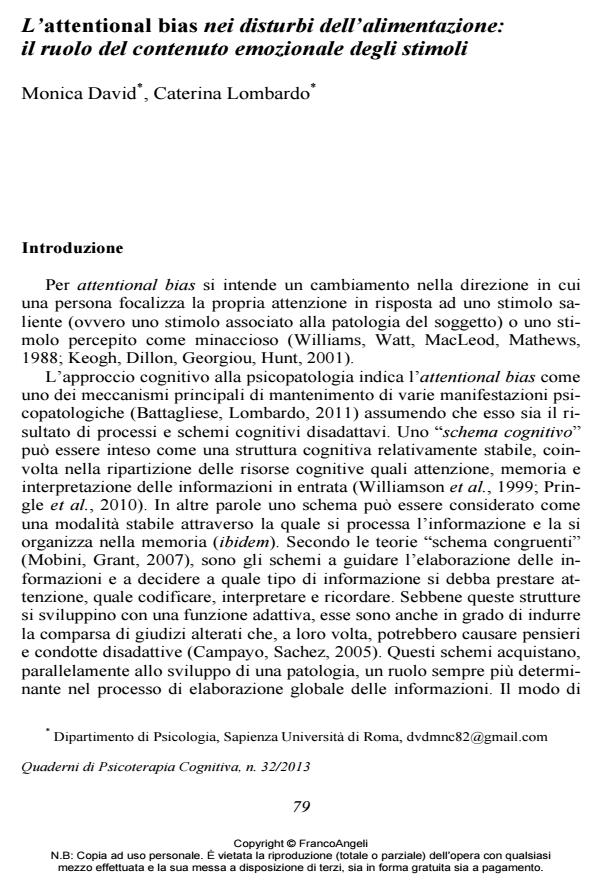L’attentional bias nei disturbi dell’alimentazione: il ruolo del contenuto emozionale degli stimoli
Journal title QUADERNI DI PSICOTERAPIA COGNITIVA
Author/s Monica David, Caterina Lombardo
Publishing Year 2013 Issue 2013/32
Language Italian Pages 18 P. 79-96 File size 453 KB
DOI 10.3280/QPC2013-032006
DOI is like a bar code for intellectual property: to have more infomation
click here
Below, you can see the article first page
If you want to buy this article in PDF format, you can do it, following the instructions to buy download credits

FrancoAngeli is member of Publishers International Linking Association, Inc (PILA), a not-for-profit association which run the CrossRef service enabling links to and from online scholarly content.
Attentional bias in eating disorders: the role of emotional content of the stimuli The scientific literature has emphasized for years the role of the attentional bias in the aetiology and maintenance of psychopathology. The attentional bias can be defined as the change in the direction in which an individual focuses his attention in response to a salient stimulus, i.e. a stimulus related to the disease or perceived as threatening. The present review examines studies conducted in the field of eating disorders with the aim of evaluating whether results differ as a function of the paradigm used for assessing attentional bias or the emotional content of the stimuli. Most studies used the Stroop paradigm evidencing the different behaviour of patients with anorexia and bulimia nervosa: while the first group seem more focused on the body, the second responds also to the stimuli related to food. These results are probably due to the activation of different mechanisms. When facing with stimuli related to food, patients with anorexia nervosa activate a cognitive avoidance response while bulimia nervosa patients activate a craving response. Moreover, using different paradigms (odd-one-out and dot-probe), two different components of the attentional bias construct were recognized: speeded detection (to shift attention towards) and increased distraction (the difficult to divert attention from). However these paradigms, widely used in the field of anxiety disorders, have been seldom used in the field of eating disorders. Thus more studies are needed in order to draw definitive conclusions.
Keywords: Attentional bias, eating disorders, anorexia nervosa, bulimia nervosa, body exposure, food exposure
Monica David, Caterina Lombardo, L’attentional bias nei disturbi dell’alimentazione: il ruolo del contenuto emozionale degli stimoli in "QUADERNI DI PSICOTERAPIA COGNITIVA" 32/2013, pp 79-96, DOI: 10.3280/QPC2013-032006